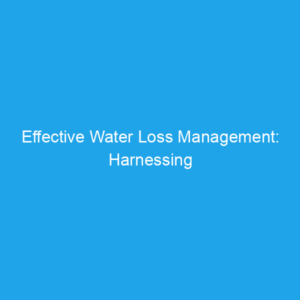By Sam Godfrey
There are two basic common sense steps that a water manager should take to improve the water system’s physical and fiscal integrity.
The first measure is to reduce the cost of water being produced by engaging programmed leak detection surveys of the system to locate those points where water is physically lost from the system before it can be delivered to end-users. When those points are identified
and repaired, the costs to pump, purchase, and treat water for delivery are commensurately reduced.
The second action that the water manager can take is to make sure that the customer meters placed in service are appropriate as to size, type, installation and that their effective
accuracy is critically monitored. Some water managers may naively believe that the newest technology brings about improved accuracy, but that is not always the case. By making sure that customer meters are performing properly over time, the water utility can realize the cash flow needed to properly maintain an efficient system.
Of course, when all customers are paying their fair share for the water they use, wasteful use of water is reduced and available water resources are conserved.
How much water and dollars can your system afford to lose?
As water systems plan their budgets for the coming fiscal year, they have to take into account the possibility of significant seasonal changes that may affect demand and
water revenue, although seasonal changes and drought are beyond our immediate control, we can use programmed leak detection measures to reduce the cost of excessive pumping.
In addition, by proper and critical attention to meter management on both production and consumer sides the utility manager will have the funds required to develop and maintain an efficient, safe and reliable water system.
It’s the old, proverbial Win-Win.
TEXAS WATER CODE: WATER AUDITS
Sec. 16.0121. WATER AUDITS.
(a) In this section, “retail public utility” has the meaning assigned by Section 13.002.
(b) Except as provided by Subsection (b-1), a retail public utility providing potable water shall perform and file with the [Texas Water Development Board] an annual water audit computing the utility’s system water loss during the preceding year.
(b-1) A retail public utility providing potable water that does not receive from the board financial assistance and is providing service to 3,300 or fewer connections shall perform and file with the board every five years a water audit computing the utility’s most recent annual system water loss.
The board shall develop appropriate methodologies and submission dates for a water audit required under Subsection (b) or (b-1) for the following categories of retail public utilities:
- (1) retail public utilities serving populations of 100,000 or more;
- (2) retail public utilities serving populations of 50,000 or more but less than 100,000;
- (3) retail public utilities serving populations of more than 10,000 but less than 50,000; and
- (4) retail public utilities serving populations of 10,000 or less.
(d) In developing the methodologies required by Subsection (c), the board shall ensure that each methodology:
- (1) is financially feasible for the category of retail public utility for which it is developed; and
- (2) considers differences in population density, source of water supply, the mean income of the service population, and other factors determined by the board.
(e) The methodologies required by Subsection (c) shall account for various components of system water loss, including loss from distribution lines, inaccuracies in meters or accounting practices, and theft.
(f) The board shall compile the information included in the water audits required by Subsections (b) and (b-1) according to category of retail public utility and according to regional water planning area. The regional planning group for a
regional planning area shall use the information to identify appropriate water management strategies in the development of a regional water plan under Section 16.053.
(g) A retail public utility providing potable water that receives from the board financial assistance shall use a portion of that financial assistance, or any
additional financial assistance provided by the board for the purpose described by this subsection, to mitigate the utility’s system water loss if, based on a water
audit filed by the utility under this section, the water loss meets or exceeds the threshold established by board rule.
(h) For each category of retail public utility listed in Subsection (c), the board shall adopt rules regarding:
- (1) the amount of system water loss that requires a utility to take action under Subsection (g); and
- (2) the use of financial assistance from the board as required by Subsection (g) to mitigate system water loss.
State funding can help pay for repair
Several well-stocked state funds are available to help a utility repair its leaking infrastructure. Here’s a brief list:
- The Texas Water Development Fund
- The Water Infrastructure Fund
- The Rural Water Assistance Fund
- The Agricultural Water Conservation Grant and Loan Program
- The Economically Distressed Areas Program
For more information, contact the Texas Water Development Board at 512-563- 4841 or click here.












